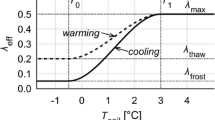Abstract
Land surface schemes used in atmospheric and hydrologic models require the specification of initial soil-temperature profiles. However, detailed soil temperature information is generally unavailable, hence modellers sometimes recur to specifying simplified initial conditions such as vertically constant profiles, assuming that the harmonic heating at the soil surface induces a rapid equilibrium to a steady periodic state. In this paper, using both numerical and analytical approaches, it is shown that such a transition to a steady periodic state is not always very rapid. In particular, it is demonstrated that the characteristic time required to reach equilibrium is highly dependent on the precise timing of initialisation with respect to the cycle of surface heating, and that initialising at the instant coincident with the occurrence of the maximum soil heat flux is the preferred mode.


Similar content being viewed by others
References
Bender CM, Orszag SA (1984) Advanced mathematical methods for scientists and engineers. McGraw Hill, Auckland, New Zealand, 593 pp
Bischoff-Gauß I, Kalthoff N, Fiebig-Wittmaack M (2006) The influence of a storage lake in the Arid Elqui Valley in Chile on local climate. Theor Appl Climatol 85. DOI 10.1007/s00704–005–0190–8
Caplan P, Derber J, Gemmill W, Hong SY, Pan HL, Parish D (1997) Changes to the NCEP operational medium-range forecast model analysis/forecast system. Weather Forecast 12:581–594
Carslaw HS, Jaeger JC (1959) Conduction of heat in solids. Clarendon, Oxford, 510 pp
Cheng WYY, and Steenburgh WJ (2005) Evaluation of surface sensible weather forecasts by the WRF and the Eta Models over the western United States. Weather Forecast 20:812–821
Cracknell AP, Xue Y (1996) Thermal inertia determination from space: a tutorial review. Int J Remote Sens 17:431–461
Dai Y, Zeng X, Dickinson RE, Baker I, Bonan GB, Bosilovich MG, Denning AS, Dirmeyer PA, Houser PR, Niu G-Y, Oleson KW, Schlosser CA, Yang Z-L (2003) The common land model (CLM). Bull Am Meteorol Soc 84:1013–1023
Deardorff JW (1978) Efficient prediction of ground surface temperature and moisture, with an inclusion of a layer of vegetation. J Geophys Res 83:1889–1903
de Foy B, Molina LT, Molina MJ (2006) Satellite-derived land surface parameters for mesoscale modelling of the Mexico City basin. Atmos Chem Phys 6:1315–1330
De Ridder K, Gallée H (1998) Land surface-induced regional climate change in southern Israel. J Appl Meteorol 37:1470–1485
Garratt JR (1992) The atmospheric boundary layer. Cambridge University Press, Cambridge, 316 pp
Goutorbe J-P, Lebel T, Dolman AJ, Gash JHC, Kabat P, Kerr Y, Montey B, Prince SD, Stricker JMM, Tinga A, Wallace JS (1997) An overview of HAPEX-Sahel: a study in climate and desertification. J Hydrol 189:4–17
Gradshteyn IS, Ryzhik IM (1965) Table of integrals, series, and products. Academic, New York, 1086 pp
Kalnay MK, Baker WE (1990) Global numerical weather prediction at the National Meteorological Center. Bull Am Meteorol Soc 71:1410–1428
Lauwaet D, De Ridder K, van Lipzig N (2008) The influence of soil and vegetation parameters on atmospheric variables relevant for convection in the Sahel. J Hydrometeorol (in press)
LeMone MA, Grossman RL, Coulter RL, Wesley ML, Klazura GE, Poulos GS, Blumen W, Lundquist JK, Cuenca RH, Kelly SF, Brandes EA, Oncley SP, McMillen RT, Hicks BB (2000) Land–atmosphere interaction research, early results, and opportunities in the Walnut River watershed in southeast Kansas: CASES and ABLE. Bull Am Meteorol Soc 81:757–779
Lynn BH, Stauffer DR, Muñoz R, Wetzel PJ, Tao W-K, Alpert P, Perlin N, Baker RD, Boone A, Jia Y (2001) Improved simulation of Florida summer convection using the PLACE land model and a 1.5-order turbulence parameterization coupled to the Penn State-NCAR mesoscale model. Mon Weather Rev 129:1441–1461
Maxwell RM, Chow FK, Kollet SJ (2007) The groundwater–land-surface–atmosphere connection: soil moisture effects on the atmospheric boundary layer in fully-coupled simulations. Adv Water Resour 30:2447–2466
Mengelkamp H-T, Warrach K, Raschke E (1999) SEWAB: a parameterization of the surface energy and water balance for atmospheric and hydrologic models. Adv Water Resour 23:165–175
Mihailovic DT, Lalic B, Arsenic B, Eitzinger J, Dusanic N (2002) Simulation of air temperature inside the canopy by the LAPS surface scheme. Ecol Model 147:199–207
Monteith JL, Unsworth MH (1990) Principles of Environmental Physics, 2nd edn. Arnold, London, 291 pp
Nagai H (2002) Validation and sensitivity analysis of a new atmosphere-soil-vegetation model. J Appl Meteorol 41:160–176
Pérez-Landa G, Ciais P, Sanz MJ, Gioli B, Miglietta F, Palau JL, Gangoiti G, Millán MM (2007) Mesoscale circulations over complex terrain in the Valencia coastal region, Spai, part 1: simulation of diurnal circulation regimes. Atmos Chem Phys 7:1835–1849
Pielke RA Sr (2002) Mesoscale meteorological modeling, 2nd edn. Academic, San Diego, CA
Press WH, Teukolsky SA, Vetterling WT, Flannery BP (1992) Numerical recipes in Fortran 77, vol 1. Cambridge University Press, Cambridge, 934 pp
Seneviratne SI, Luthi D, Litschi M, Schar C (2006) Land-atmosphere coupling and climate change in Europe. Nature 443:205–209
Thunis P, Cuvelier C (2000) Impact of biogenic emissions on ozone formation in the Mediterranean area: a BEMA modelling study. Atmos Environ 34:467–481
Zhong S, Fast JD, Bian X (1996) Case study of the Great Plains low-level jet using wind profiler network data and a high-resolution mesoscale model. Mon Weather Rev 124:785–806
Acknowledgements
The research described here was carried out in the project “Measuring urban surfaces’ thermal inertia” (MUSTI), which is supported by the PRODEX programme of the European Space Agency (ESA) and the Belgian Science Policy Office. We would also like to acknowledge support from EU COST Action 728 “Enhancing mesoscale meteorological modelling capabilities for air pollution and dispersion applications”.
Author information
Authors and Affiliations
Corresponding author
Rights and permissions
About this article
Cite this article
De Ridder, K. Soil temperature spin-up in land surface schemes. Theor Appl Climatol 95, 341–347 (2009). https://doi.org/10.1007/s00704-008-0011-y
Received:
Accepted:
Published:
Issue Date:
DOI: https://doi.org/10.1007/s00704-008-0011-y




